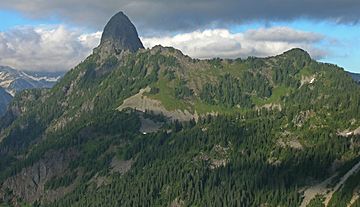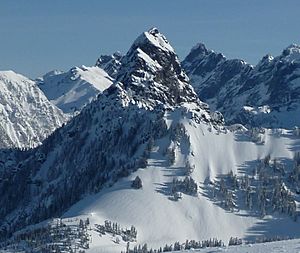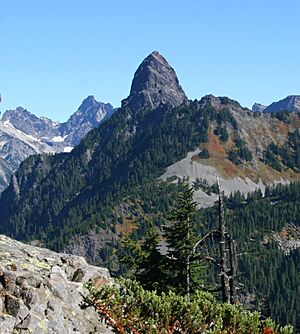Mount Thomson facts for kids
Quick facts for kids Mount Thomson |
|
|---|---|

Mount Thomson
|
|
| Highest point | |
| Elevation | 6,554 ft (1,998 m) |
| Prominence | 1,514 ft (461 m) |
| Isolation | 2.33 mi (3.75 km) |
| Parent peak | Chikamin Peak |
| Geography | |
| Location | King County Washington state, U.S. |
| Parent range | Cascade Range |
| Topo map | USGS Chikamin Peak |
| Type of rock | Keechelus andesite |
| Climbing | |
| First ascent | 1917 Joe Hazard, B. French |
| Easiest route | Scrambling East Ridge |
Mount Thomson is a tall mountain in Washington state. It stands at about 6,554 feet (1,998 meters) high. This mountain is located in the eastern part of King County. It is also part of the beautiful Alpine Lakes Wilderness.
Mount Thomson is a peak in the Cascade Range. It sits about half a mile east of the main ridge of the Cascades. You can find it about 4 miles (6 km) northeast of Snoqualmie Pass. The land around the mountain is managed by the Mount Baker-Snoqualmie National Forest. Water from the mountain flows into the Middle Fork of the Snoqualmie River.
The closest mountain is Alaska Mountain, which is about 0.81 miles (1.3 km) away. The nearest higher peak is Chikamin Peak, located about 2.08 miles (3.3 km) to the east. Mount Thomson was named after Reginald H. Thomson, a Seattle city engineer. He helped design many parts of the city. The mountain's name used to be spelled "Thompson." But in 1981, the U.S. Board on Geographic Names officially changed it to "Thomson." The first people to climb this peak were Joe Hazard and B. French in 1917.
Understanding Mount Thomson's Climate
Mount Thomson is in a "marine west coast" climate zone. This means it gets a lot of influence from the ocean. Most of the weather systems start over the Pacific Ocean. They then travel northeast towards the Cascade Range.
When these weather systems reach the Cascade Mountains, the air is forced to rise. This process is called Orographic lift. As the air rises, it cools down and drops its moisture. This moisture falls as rain or snow on the mountains. Because of this, the western side of the Cascades gets a lot of rain and snow. This is especially true during the winter months.
The snow here tends to be wet and heavy. This can create a high risk of avalanches. During winter, the weather is often cloudy. However, in summer, high-pressure systems over the Pacific Ocean bring clear skies. The best time to visit or climb Mount Thomson is usually from July through September. This is when the weather is most pleasant.
Exploring Mount Thomson's Geology
The Alpine Lakes Wilderness is known for its rugged landscape. It has jagged peaks, long ridges, and deep valleys carved by glaciers. You can also see tall granite walls and over 700 mountain lakes. The amazing shapes of the land were created by geological events. These events happened millions of years ago. They also led to the big changes in elevation and climate across the Cascade Range.
The Cascade Mountains began to form millions of years ago. This was during a time called the late Eocene Epoch. The North American Plate was slowly moving over the Pacific Plate. This movement caused many periods of volcanic activity. Also, small pieces of land called terranes joined together. This helped create the North Cascades about 50 million years ago.
Later, during the Pleistocene period, glaciers played a big role. This period started over two million years ago. Huge sheets of ice moved across the land many times. They carved and shaped the landscape. The last glaciers in the Alpine Lakes area started to melt about 14,000 years ago. They had moved north of the Canada–US border by 10,000 years ago. The valleys here have a "U"-shape. This shape is a clear sign of past glaciation. The combination of land uplift, fault lines, and glaciers created the tall peaks and deep valleys we see today.





